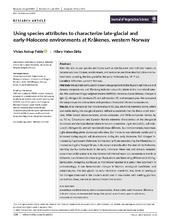| dc.description.abstract | Aim: We aim to use species attributes such as distributions and indicator values to reconstruct past biomes, environment, and temperatures from detailed plant‐macrofossil data covering the late glacial to the early Holocene (ca. 14–9 ka). Location: Kråkenes, western Norway. Methods: We applied attributes for present‐day geographical distribution, optimal July and January temperatures, and Ellenberg indicator values for plants in the macrofossil data‐set. We used assemblage weighted means (AWM) to reconstruct past biomes, changes in light (L), nitrogen (N), moisture (F), and soil reaction (R), and temperatures. We compared the temperature reconstructions with previous chironomid‐inferred temperatures. Results: After the start of the Holocene around 11.5 ka, the Arctic‐montane biome, which was stable during the late‐glacial period, shifted successively into the Boreo‐arctic montane, Wide‐boreal, Boreo‐montane, Boreo‐temperate, and Wide‐temperate biomes by ca. 9.0 ka. Circumpolar and Eurasian floristic elements characteristic of the late‐glacial decreased and the Eurosiberian element became prominent. Light demand (L), soil moisture (F), nitrogen (N), and soil reaction (R) show different, but complementary responses. Light‐demanding plants decreased with time. Soil moisture was relatively stable until it increased during organic soil development during the early Holocene. Soil nitrogen increased during the early Holocene. Soil reaction (pH) decreased during the Allerød, but increased during the Younger Dryas. It decreased markedly after the start of the Holocene, reaching low but stable levels in the early Holocene. Mean July and January temperatures show similar patterns to the chironomid‐inferred mean July temperature trends at Kråkenes, but chironomids show larger fluctuations and interesting differences in timing. Conclusion: Assigning attributes to macrofossil species is a useful new approach in palaeoecology. It can demonstrate changes in biomes, ecological conditions, and temperatures. The late‐glacial to early‐Holocene transition may form an analogue for changes observed in the modern arctic and in mountains, with melting glaciers, permafrost thaw, and shrub encroachment into tundra. | en_US |

